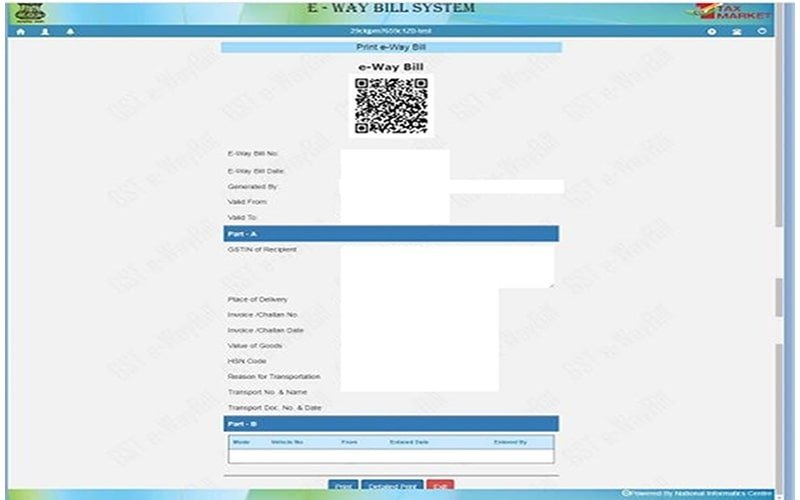![]()
DID YOU KNOW ALL ABOUT E-WAY BILL CONCEPT AND RELATED PROVISION UNDER GST?
CA.Jayprakash Pandey
Below article explains the concept of E-way bill and various provision related to E Way bill
- Why E way bill is required?
- What is an E Way Bill?
- When should E-Way bill be generated?
- What If supply is Intrastate?
- Who has to generate E-Way Bill?
- Does E-Way Bill to be generated even if Value less than 50000?
- How many E-Way bill to be issued in case of Bill To Ship To model?
- What details to be furnished in E-Way bill?
- What is Form GST EWB-02?
- What is Validity of E-Way Bill?
- What E-Way bill provision in case of Export and Import of goods?
- What is Vahan System?
- Why E-way bill system needs integration with VAHAN System?
- What is step by step Guide to Generate EWay Bill (EWB-01) online?
- How the e-Way Bill looks like when generated online?
- Some special points related to E Way Bill
Why E way bill is required?
It helps to identify the movement of goods at every state and thus helps prevent tax evasion (If bill is not accounted by either by seller or buyer).
What is an E Way Bill? (From 1.04.2018)
E WAY Bill is an Electronic Way Bill for the movement of Goods to be generated on the E WayBill Portal.
When should E-Way bill be generated?
It is to be generated when it satisfied 3 conditions-
- Movement of goods in a vehicle/ conveyance.
- Only in case of Interstate Movement of goods
- Where invoice value exceeds Rs. 50,000 (either each Invoice or in aggregate of all invoices in a such vehicle/conveyance)
The E-Way Bill is to be generated
- In relation to supply
- In relation to return
- Purchase from unregistered person
What If supply is Intrastate?
State will notify intrastate limits for generation of E-Way Bill.
E-way bill has also been made applicable in phased manner for intra-state movement of goods by June 3, 2018 and has been notified in each state.
Who has to generate E-Way Bill?
- Registered Person – Eway bill MUST be generated when there is a movement of goods in excess ofRs 50,000 in value to or from a registered person. A Registered person or the transporterMAY choose to generate and carry eway bill even if the value of goods is less than Rs 50,000.
- Unregistered Persons – Unregistered persons are also required to generate e-Way Bill. However, where a supply is made by an unregistered person to a registered person, the receiver (registered person) will have to ensure all the compliances are met as if they were the supplier.
- Transporter – Transporters carrying goods by road, air, rail, etc. also need to generate e-Way Bill if the supplier has not generated an e-Way Bill.
Illustrative cases to understand – who can generate E-way bill?
| Case 1 :-
Seller and Buyer both are registered |
Then E way bill should be generated by Seller |
| Case 2:-
Seller (Unregistered) and Buyer registered |
Then E way bill should be generated by Buyer |
| Case 3:
Seller and Buyer both are unregistered |
Then E way bill should be generated by Transporter |
Note:–Unregistered Transporters will be issued Transporter ID on enrolling on the e-way bill portal after which Eway bills can be generated.
Does E-Way Bill to be generated even if Value less than 50000?
The E-Way bill is to be generated even if value is less than 50000 in the following two cases: 1. Inter-State transfer of goods by Principal to Job worker.
- Inter-State transfer of handicraft goods by a person exempted from obtaining registration.
How many E-Way bill to be issued in case of Bill To Ship To model?
In case of Bill To Ship To Modelonly One E-Way Bill to be generated Either by A (Seller) Or by B (Buyer)
B (Buyer) directs A (Seller) to send goods to C (Original Recipient)
Two supplies are involved in the above transaction
B to take ITC on invoice issued by A
C to take ITC on invoice issued issued by B.
What details to be furnished in E-Way bill?
Form GST EWB-01 Contains two parts–
Part A Contains details of Seller &RecipientsSuch as name,address GSTIN of Seller /recipients,Place of delivery,HSN Codeetc
Part B Contains Details of Transporter (It is not Mandatory – If distance is upto 50 kms)
What is Form GST EWB-02?
Where in one conveyance multiple consignments are intended to be transporter. In such case transporter may indicate serial no. of e-way bill generated in respect of EACH such consignment
A Consolidated E-Way Bill may be prepared by him (Transporter) in FORM GST EWB-02 before movement of goods.
What is Validity of E-Way Bill?
Explanation:- For a distance of less than 200 Km, the e-way bill will be valid for a day from the relevant date. For every 200 Km thereafter, the validity will be additional one day from the relevant date. If goods cannot be transported within the validity period of the e-way bill, the transporter may generate another e-way bill after updating the details in Part B of FORM GST EWB-01.
Validity of E way bill can be extended also.
Section 93 of Central Motor Vehicle Rules 1989, made under Motor Vehicles Act 1988 defines the concept of over dimensional cargo (ODC).
What E-Way bill provision in case of Export and Import of goods?
In case of Export: -The e-way bill has to be generated when the goods are being moved to port for exportation.
Example:-
Customer Premises being moved to the Port – Yes,E-way will be generated
But from Port to foreign country – No,E-way will be generated
Relaxation: –Export of Goods to Nepal and Bhutan has been exempted by Government.
In case of Export: -The e-way bill has to be generated when the goods are being moved to the customer premises from port.
Example:-
Foreign country to Port – No,E-way will be generated.
But from Port to customer premises – Yes,E-way will be generated.
What is Vahan System?
Vahan is a National register containing details related to registered vehicles. Details of registered vehicles can be searched on VAHAN.
Why E-way bill system needs integration with VAHAN System?
Such integration is required to check /validate whether the registration number of a vehicle at the time of preparing an e-way bill. Any attempt to use a vehicle number for e-way bill generation but not registered on the VAHAN system will NOT be allowed.
What is step by step Guide to Generate EWay Bill (EWB-01) online?
- Go to ewaybill.gst.in – Click to login on top right side corner.
- Enter the Username, password and Captcha code& then Click on ‘Login’.
- Click on ‘Generate new’ under ‘E-waybill’ option appearing on the left-hand side
- Fill all the details in Part A and Part B of this bill and then click on submit.
How the e-Way Bill looks like when generated online?
Some special points related to E Way Bill
- Part B of e-Way Bill is not required to be filled where the distance between the consigner or consignee and the transporter is less than 50 Kms and transport is within the same state.
- Invoice Value means transaction value as per Invoice inclusive of all the taxes excluding the Value of exempt goods that are being carried along the taxable goods and billed together.
- Value of consignment of Goods is interpreted as follows:
Invoice Value exceeds Rs. 50,000 OR
If a vehicle carries goods against multiple Invoices, then where the aggregate Invoice value exceed Rs. 50,000
So, if either of above points is satisfied, the user should generate e-Way Bill.
- For Noncompliance of E Way Bill rules,Taxable Person shall be liable to a penalty of 10,000/- or tax sought to be evaded (wherever applicable) whichever is greater.
- As per Rule 138E, if a registered person who is a composition dealer has not filed GST returns for two consecutive tax periods or registered person other than composition dealers, if they do not file their GST returns for a consecutive period of two months or registered person who has not furnished GSTR-1 of last 2 months or for a quarter or registered person whose registration has been suspended under the provisions of sub-rule (1) or sub-rule (2) or sub-rule (2A) of rule 21A, e-way bill can-not be generated for making supply to or by him.
Readers may forward their feedback/suggestion & queries at cajayprakashpandcompany@gmail.com or Leave your thoughts in comment section in order to help other member/readers.
BIO of Author:-
The author, CA Jayprakash Pandey is a practicing Chartered Accountant (Founder of Jayprakash P & Company) having Office at Mumbai, with more than 5 years of professional cum practical experience, Direct Tax, International Taxation, Indirect Tax & FEMA related advisory, litigation & compliance matters.
Disclaimer:
The purpose of this is to share knowledge and it is for education purpose only. This does NOT constitute NOR does this form part of neither it is to be construed as, A LEGAL OPINION. The analysis is solely based on the reading abilities of the Author. They may be correct/incorrect as per you. No representation or warranty, express or implied, is made or given in respect of any information provided. UNDER NO circumstances should any recipient rely on this communication as a basis for any legal decision. The views expressed are of personal to the author. They do not reflect the views of any organization he may be directly/indirectly associated with. Neither author nor any of its affiliates accepts any legal liability, or responsibility, for, or provides any assurance or guarantee of accuracy, authenticity, completeness, correctness, dependability, reliability, suitability or timeliness of, any part of this article. The contents of this article are based only on the understanding of the Law, Rules, Notifications, etc. of the author and THEY ARE NOT BASIS FOR ANY LEGAL OPINION.




